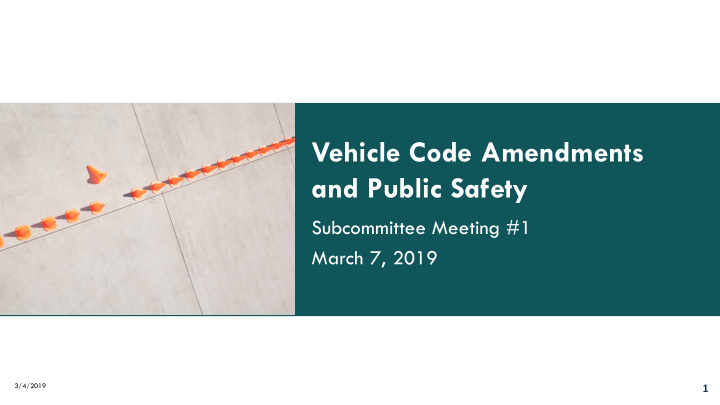



Vehicle Code Amendments and Public Safety Subcommittee Meeting #1 March 7, 2019 3/4/2019 1
Welcome and Introductions 3/4/2019 2
Review of Round 1 Recommendations and Round 2 Scoping Results 3/4/2019 3
Relevant Recommendations from 2018 AV Task Force Report Vehicle Code Safety • Licensing requirements should ensure that any The task force emphasized the importance of human who performs any aspect of the driving task ensuring the safety of all road users, including should possess valid driving privileges, even if the vulnerable road users such as pedestrians, automated driving system controls the vehicle for bicyclists, and motorcyclists. the majority of the trip. While new endorsements Safety requirements: specific to autonomous vehicles are not 1. Certification that vehicles comply with Federal recommended at this time, a driver should possess Motor Vehicle Safety Standards or Federal Motor a class of license appropriate to the vehicle being Carrier Safety Regulations, or have an exemption driven (e.g., a commercial driver license for 2. Certification that vehicle can comply with all operation of a commercial vehicle). In Level 3 state vehicle and traffic laws within its operational through 5 vehicles, a human driver may be design domain, or that an exemption has been responsible for the driving behavior of the vehicle granted by ODOT18 at times it is under human control, while at others 3. Certification that vehicle has means to engage the driving behavior is the responsibility of the and disengage autonomous technology that is automated driving system and its manufacturer. easily accessible to operator 3/4/2019 4
Relevant Recommendations from 2018 AV Task Force Report 3. Secure link to remote operator who can assume Safety requirements (cont): control of the vehicle or have the vehicle achieve 4. Certification that vehicle has a visual indicator minimal risk condition inside the cabin to indicate when the autonomous technology is engaged, if the vehicle is designed to 4. Certification that vehicle meets the description of allow for a human driver in the vehicle an SAE Level 4 or 5 vehicle 5. Certification that a human driver will be ready 5. Description of operational design domain of to assume control or have the vehicle achieve vehicle minimal risk condition at all times 6. Certification that manufacturer provides training program for remote operators Additional safety requirements for testing without a 7. Publicly disclosed assessment demonstrating human backup driver: safety approach 1. Notification of local authorities where testing is 8. Manufacturer must revise permit application if to take place technology changes significantly 2. Certification that vehicle is capable of operating without a driver inside 3/4/2019 5
Scoping Results from December 2018 Law Enforcement • Changes to ticketing forms and procedures Workshop • Ensure that AVs appropriately defer to emergency vehicles Principles – Anti-tampering provisions for vehicle systems • Don’t reinvent the wheel – Make sure there is accountability and recourse for victims of AV crashes – Prioritize applicability of existing law • – Should AVs be visibly identified as such? Keep existing civil legal remedies • Maintain existing law enforcement structure to the extent possible AV Design Safety • How do AVs communicate intent to other road users? • Achieve Vision Zero: Make sure vulnerable road users and • Make sure AV fleets are accessible & improve mobility for active transportation users are not adversely impacted by transportation-disadvantaged AVs • How do we preserve safety in a mixed environment? Other Considerations Licensing and Registration Procedures • Are there health or safety issues around new commercial AV • Establish roles, responsibilities & definitions of driver and services? other vehicle users • Transportation during natural disasters – how to evacuate during • Changes to crash reporting and forms and procedures hazardous events in an AV world • Track and address the range of models for automated freight (long-haul vs. local delivery, etc.) • Should there be a separate vehicle code for AVs / amendments to existing vehicle code? 3/4/2019 6
State and Federal Roles in Vehicle and Driver Regulation 3/4/2019 7
Federal State Regulating motor vehicles and motor Regulating human drivers and other vehicle equipment aspects of motor vehicle operation • Set Federal Motor Vehicle Safety • License drivers Standards • Register motor vehicles • (FMVSS) for motor vehicles and • Regulate insurance and liability equipment • Enact and enforce traffic laws • Enforce compliance with FMVSS • Conduct safety inspections, where • Manage safety recalls states choose to do so • Educate public about safety 3/4/2019 8
Revisions to Subcommittee Scope and Discussion of Final Product 3/4/2019 9
Possible Final Product Goals • Investigate and document any existing national guidance or national initiatives to develop guidance • Identify what other states are doing related to this topic • Develop short-term and long-term recommendations for safety to prepare for AVs • Others? 3/4/2019 10
Recap and Next Steps 3/4/2019 11
Recommend
More recommend